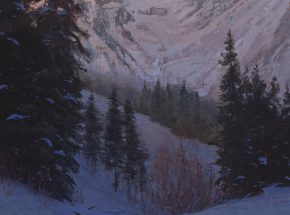

Steven Lee Adams spent three years at Brigham Young University. He was accepted into the Bachelor of Fine Arts program in his first semester, an honor usually reserved for third year students. He has garnered many awards, including “Best of Show” at The 66th Annual April Salon, Utah’s most prestigious art show.
In 1989, Steven began doing work with Indian and wildlife artist, Michael Coleman and Neo-regionalist, Gary Ernest Smith. He considers the experience of being in and out of their studios on a regular basis instrumental in his development from art student to professional artist.
Steven initially built, carved, and gilded many of his frames. Now he oversees much of this work and considers the presentation of art an integral part of the whole, selecting frame styles and finishes that he feels enhance the overall impact of each piece.
His work is tied most closely with the Tonalist artists who worked at the turn of the last century. Their primary focus was the spiritual undertones of landscapes. The most notable artist of this movement was George Inness. In his own paintings Steve is searching for the intangible feeling of timelessness that lies beneath the surface of what may seem commonplace. This effort lies directly opposite of the impressionists who tried essentially to capture a specific moment in time.
These are introspective paintings, urging us to look deeper; not only for the subtleties of nature around us, but also at the complex world of emotion within each of us.
“In painting, I see two distinct elements that excite me equally. The first and most obvious is the optical illusion of three dimensions. For me this represents a personal vision of my world. It can also be a trap and if not tempered can seduce the artist to focus an inordinate amount of energy on it, being the most quickly gratifying of the two and quickly applauded by people from all walks of life. The second is the two dimensional nature of a painting. Many artists see this element as only a means to an end (the end being the trick of the third dimension).
Personally, I find the juxtaposition of brush stroke, canvas or ground, underpainting, glazing and color, as gratifying as the illusion of space- if not more so. These elements have more in common with abstraction and their interplay when taken at close range can have stunning emotional impact to those who take the time to experience them.
Given this, the combination of these two forces, if properly executed within any work of representational art, has enormous power to uplift and at times overwhelm the receptive viewer. Therein lies the fundamental reasoning behind what I am striving to achieve.”
-Steven Lee Adams
http://marywilliamsfinearts.com/
Website
http://www.
